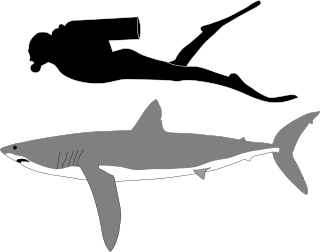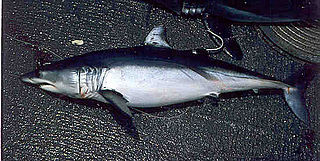
Clupeiformes is the order of ray-finned fish that includes the herring family, Clupeidae, and the anchovy family, Engraulidae. The group includes many of the most important forage and food fish.

Pristigasteridae is a family of ray-finned fish related to the herrings, including the genera Ilisha, Pellona, and Pristigaster. One common name for the taxon is longfin herring. The taxonomic classification of this family is in doubt; it was traditionally divided into two subfamilies, Pelloninae and Pristigasterinae, but molecular data indicates that these are not monophyletic.

The Lamnidae are the family of mackerel or white sharks. They are large, fast-swimming sharks, found in oceans worldwide. The name of the family is formed from the Greek word, lamna, which means fish of prey, and was derived from the Greek legendary creature, the Lamia.

The longfin inshore squid is a species of squid of the family Loliginidae.

The longfin mako shark is a species of mackerel shark in the family Lamnidae, with a probable worldwide distribution in temperate and tropical waters. An uncommon species, it is typically lumped together under the name "mako" with its better-known relative, the shortfin mako shark. The longfin mako is a pelagic species found in moderately deep water, having been reported to a depth of 220 m (720 ft). Growing to a maximum length of 4.3 m (14 ft), the slimmer build and long, broad pectoral fins of this shark suggest that it is a slower and less active swimmer than the shortfin mako.

The longfin sawtail catshark is a rare, little-known species of catshark, part of the family Scyliorhinidae. Once thought to be a subspecies of the roughtail catshark along with the Antilles catshark, it inhabits deep water off the Caribbean coasts of Panama and Colombia. This slim-bodied species has a marbled dorsal color pattern and a prominent crest of enlarged dermal denticles along the dorsal edge of its caudal fin. It can be distinguished from similar species by its relatively longer anal fin and small adult length of under 35 cm (14 in). The longfin sawtail catshark is oviparous.

Crenimugil is a genus of mullets found in coastal marine waters and rivers in the Indo-Pacific region.
Moolgarda is a genus of mugilid mullets found in coastal waters of the Indo-Pacific, including estuaries and rivers.

Isurus is a genus of mackerel sharks in the family Lamnidae, commonly known as the mako sharks.

The longfin trevally, also known as the longfin kingfish, longfin cavalla or armed trevally, is a species of inshore marine fish in the jack family, Carangidae. The species is common in tropical to subtropical waters of the Indo-Pacific, ranging from South Africa in the west to Japan in the east, typically inhabiting inshore reefs and bays. The species is easily distinguished by its elongate dorsal and anal fin lobes and filamentous dorsal rays, as well as its scaleless breast. Longfin trevally are pelagic predators, taking a variety of small fish, cephalopods and crustaceans, and reach sexual maturity at around 21 cm. The species has a maximum known length of 57 cm and weight of 3.5 kg. The longfin trevally has a very complex taxonomic history which is closely intertwined with another currently valid species, Carangoides ciliarius, which may yet prove to be synonymous. Longfin trevally are of minor importance to fisheries throughout their range and are considered good table fish, and are occasionally taken by anglers.

The longfin crevalle jack is a recently described species of large marine fish classified in the jack family, Carangidae. It inhabits the subtropical waters of the east Atlantic Ocean, ranging along the African coast from Mauritania south at least to Moçamedes in southern Angola, with the species historically present in the Mediterranean Sea. It is an inshore species, known to occasionally penetrate estuaries, possibly to spawn. The species is very similar to the crevalle jack, Caranx hippos, and is separated by its extended dorsal and anal fin lobes as well as more detailed anatomical features including dorsal and anal fin ray counts. The fish is known to reach 127 cm in length and 20.9 kg in weight. The longfin crevalle jack is a predatory fish, taking small fish as its main prey. Due to longstanding confusion between C. fischeri and C. hippos, the importance of each species to African fisheries is poorly understood, with a known combined catch in this region of between 2,233 and 10,054 tonnes per year in 1995–2004. Like its close relatives, the species is considered a powerful gamefish and highly sought after, although their coarse flesh makes for relatively poor quality food.
The longfin dace is a leuciscid fish that is found in western North America in the United States and Mexico. It is the only member of its genus. The Gila longfin dace is considered the nominate subspecies. The Yaqui longfin dace is considered a form.

Pellona ditchela, called the Indian pellona, ditchelee and the toothed shad, is a species of longfin herring native to the coasts, mangrove swamps, and estuaries of the Indian Ocean and the western Pacific, generally in tropical waters. Some individuals can reach 16 cm, with the average closer to 10 cm.

Ilisha africana, called the West African ilisha, is a species of longfin herring native to the coasts, lagoons and estuaries of western Africa from Senegal to Angola. It prefers shallow waters, and is unlikely to be found below 25 m. Some individuals can reach 30 cm, with the average closer to 18 cm.
Neoopisthopterus is a small genus of ray-finned fish in the family Pristigasteridae. There are currently two recognized species in this genus, both of which occur in tropical waters of the Western Hemisphere.
Opisthopterus is a genus of longfin herring in the family Pristigasteridae. There are currently six species in this genus.
Pliosteostoma lutipinnis, the yellowfin herring, is a longfin herring that is found along the coast of Central and South America from Mexico to Ecuador. It is the only species in its genus.

The elongate ilisha, also known as the Chinese herring or slender shad, is a species of longfin herring native to the coastal waters and estuaries of North Indian Ocean and Northwest Pacific. It is a relatively large species, up to 45–60 centimetres (18–24 in) in total length. It is an important fishery species.
Steeneichthys is a genus of ray-finned fish in the family Plesiopidae, the longfins or roundheads.












